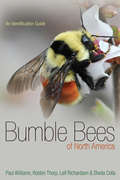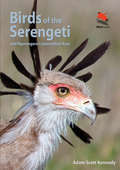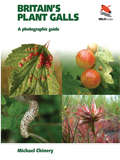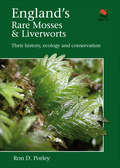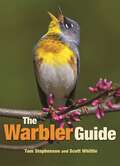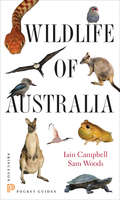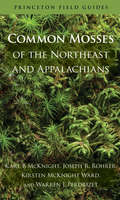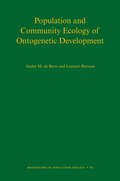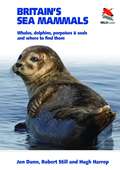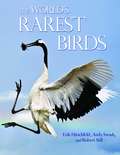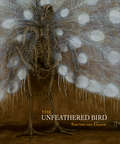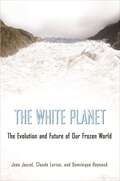- Table View
- List View
Bumble Bees of North America: An Identification Guide (PDF)
by Paul H. Williams Robbin W. Thorp Leif L. Richardson Sheila R. CollaMore than ever before, there is widespread interest in studying bumble bees and the critical role they play in our ecosystems. Bumble Bees of North America is the first comprehensive guide to North American bumble bees to be published in more than a century. Richly illustrated with color photographs, diagrams, range maps, and graphs of seasonal activity patterns, this guide allows amateur and professional naturalists to identify all 46 bumble bee species found north of Mexico and to understand their ecology and changing geographic distributions.The book draws on the latest molecular research, shows the enormous color variation within species, and guides readers through the many confusing convergences between species. It draws on a large repository of data from museum collections and presents state-of-the-art results on evolutionary relationships, distributions, and ecological roles. Illustrated keys allow identification of color morphs and social castes.A landmark publication, Bumble Bees of North America sets the standard for guides and the study of these important insects.The best guide yet to the 46 recognized bumble bee species in North America north of MexicoUp-to-date taxonomy includes previously unpublished results Detailed distribution maps Extensive keys identify the many color patterns of species
Bumble Bees of North America: An Identification Guide
by Paul H. Williams Robbin W. Thorp Leif L. Richardson Sheila R. CollaMore than ever before, there is widespread interest in studying bumble bees and the critical role they play in our ecosystems. Bumble Bees of North America is the first comprehensive guide to North American bumble bees to be published in more than a century. Richly illustrated with color photographs, diagrams, range maps, and graphs of seasonal activity patterns, this guide allows amateur and professional naturalists to identify all 46 bumble bee species found north of Mexico and to understand their ecology and changing geographic distributions.The book draws on the latest molecular research, shows the enormous color variation within species, and guides readers through the many confusing convergences between species. It draws on a large repository of data from museum collections and presents state-of-the-art results on evolutionary relationships, distributions, and ecological roles. Illustrated keys allow identification of color morphs and social castes.A landmark publication, Bumble Bees of North America sets the standard for guides and the study of these important insects.The best guide yet to the 46 recognized bumble bee species in North America north of MexicoUp-to-date taxonomy includes previously unpublished results Detailed distribution maps Extensive keys identify the many color patterns of species
Birds of the Serengeti: And Ngorongoro Conservation Area (PDF)
by Adam Scott KennedyLocated in northern Tanzania, the Serengeti is one of the world's most famous wildlife regions. Birds of the Serengeti is a groundbreaking and essential photographic guide, featuring more than 270 bird species most likely to be encountered in the Serengeti National Park and Ngorongoro Conservation Area. This easy-to-use guide includes 480 dazzling color photos, an attractive and handy layout, and informative and accessible text that discusses interesting behaviors and provides insights into species background. Rich in detail, this indispensable volume uses a habitat-based approach, making it simple for everyone—from the novice to the experienced birdwatcher—to locate diverse birds in this fascinating area of the world.Looks at more than 270 bird species most likely to be encountered in Tanzania’s Serengeti National Park, Ngorongoro Conservation Area, and Speke Gulf Features major plumage variations Habitat-based approachInformative and accessible text
Britain's Plant Galls: A Photographic Guide (PDF)
by Michael ChineryThis book has been produced with the aim of stimulating the general naturalist to take a closer look at the bumps and lumps that make up the fascinating world of plant galls. Induced by a variety of insects and other organisms and ranging from tiny pimples to bizarre and often very attractive and exquisitely sculptured growths, plant galls are mystery to many people, but they offer a fascinating field of study for both botanists and zoologists. Galls can be found on a very wide range of both woody and herbaceous plants, with over 50 different kinds occurring on Britain's oak trees alone, and there is still much to be learned about even the commonest examples. An introduction to the nature of plant galls and their formation Brief descriptions of some of the organisms that cause or induce galls Superb photographs of just over 200 of the commonest or most conspicuous of Britain's 1,000 or so plant galls, arranged according to their host plants to aid field identification Descriptions of these galls and the life histories of the organisms that cause them
A Sparrowhawk's Lament: How British Breeding Birds of Prey Are Faring (PDF)
by David Cobham Bruce Pearson Chris PackhamBritain is home to fifteen species of breeding birds of prey, from the hedgerow-hopping Sparrowhawk to the breathtaking White-tailed Eagle. In this handsomely illustrated book, acclaimed British filmmaker and naturalist David Cobham offers unique and deeply personal insights into Britain's birds of prey and how they are faring today. He delves into the history of these magnificent birds and talks in depth with the scientists and conservationists who are striving to safeguard them. In doing so, he profiles the writers, poets and filmmakers who have done so much to change the public's perception of birds of prey. There are success stories—five birds of prey that were extinct have become reestablished with viable populations—but persecution is still rife. Featuring drawings by famed wildlife artist Bruce Pearson, this book reveals why we must cherish and celebrate our birds of prey, and why we neglect them at our peril.
A Sparrowhawk's Lament: How British Breeding Birds of Prey Are Faring
by David Cobham Bruce Pearson Chris PackhamBritain is home to fifteen species of breeding birds of prey, from the hedgerow-hopping Sparrowhawk to the breathtaking White-tailed Eagle. In this handsomely illustrated book, acclaimed British filmmaker and naturalist David Cobham offers unique and deeply personal insights into Britain's birds of prey and how they are faring today. He delves into the history of these magnificent birds and talks in depth with the scientists and conservationists who are striving to safeguard them. In doing so, he profiles the writers, poets and filmmakers who have done so much to change the public's perception of birds of prey. There are success stories—five birds of prey that were extinct have become reestablished with viable populations—but persecution is still rife. Featuring drawings by famed wildlife artist Bruce Pearson, this book reveals why we must cherish and celebrate our birds of prey, and why we neglect them at our peril.
Ocean Biogeochemical Dynamics
by Jorge L. SarmientoOcean Biogeochemical Dynamics provides a broad theoretical framework upon which graduate students and upper-level undergraduates can formulate an understanding of the processes that control the mean concentration and distribution of biologically utilized elements and compounds in the ocean. Though it is written as a textbook, it will also be of interest to more advanced scientists as a wide-ranging synthesis of our present understanding of ocean biogeochemical processes. The first two chapters of the book provide an introductory overview of biogeochemical and physical oceanography. The next four chapters concentrate on processes at the air-sea interface, the production of organic matter in the upper ocean, the remineralization of organic matter in the water column, and the processing of organic matter in the sediments. The focus of these chapters is on analyzing the cycles of organic carbon, oxygen, and nutrients. The next three chapters round out the authors' coverage of ocean biogeochemical cycles with discussions of silica, dissolved inorganic carbon and alkalinity, and CaCO3. The final chapter discusses applications of ocean biogeochemistry to our understanding of the role of the ocean carbon cycle in interannual to decadal variability, paleoclimatology, and the anthropogenic carbon budget. The problem sets included at the end of each chapter encourage students to ask critical questions in this exciting new field. While much of the approach is mathematical, the math is at a level that should be accessible to students with a year or two of college level mathematics and/or physics.
Rethinking Private Authority: Agents and Entrepreneurs in Global Environmental Governance
by Jessica F. GreenRethinking Private Authority examines the role of non-state actors in global environmental politics, arguing that a fuller understanding of their role requires a new way of conceptualizing private authority. Jessica Green identifies two distinct forms of private authority--one in which states delegate authority to private actors, and another in which entrepreneurial actors generate their own rules, persuading others to adopt them. Drawing on a wealth of empirical evidence spanning a century of environmental rule making, Green shows how the delegation of authority to private actors has played a small but consistent role in multilateral environmental agreements over the past fifty years, largely in the area of treaty implementation. This contrasts with entrepreneurial authority, where most private environmental rules have been created in the past two decades. Green traces how this dynamic and fast-growing form of private authority is becoming increasingly common in areas ranging from organic food to green building practices to sustainable tourism. She persuasively argues that the configuration of state preferences and the existing institutional landscape are paramount to explaining why private authority emerges and assumes the form that it does. In-depth cases on climate change provide evidence for her arguments. Groundbreaking in scope, Rethinking Private Authority demonstrates that authority in world politics is diffused across multiple levels and diverse actors, and it offers a more complete picture of how private actors are helping to shape our response to today's most pressing environmental problems.
Rethinking Private Authority: Agents and Entrepreneurs in Global Environmental Governance
by Jessica F. GreenRethinking Private Authority examines the role of non-state actors in global environmental politics, arguing that a fuller understanding of their role requires a new way of conceptualizing private authority. Jessica Green identifies two distinct forms of private authority--one in which states delegate authority to private actors, and another in which entrepreneurial actors generate their own rules, persuading others to adopt them. Drawing on a wealth of empirical evidence spanning a century of environmental rule making, Green shows how the delegation of authority to private actors has played a small but consistent role in multilateral environmental agreements over the past fifty years, largely in the area of treaty implementation. This contrasts with entrepreneurial authority, where most private environmental rules have been created in the past two decades. Green traces how this dynamic and fast-growing form of private authority is becoming increasingly common in areas ranging from organic food to green building practices to sustainable tourism. She persuasively argues that the configuration of state preferences and the existing institutional landscape are paramount to explaining why private authority emerges and assumes the form that it does. In-depth cases on climate change provide evidence for her arguments. Groundbreaking in scope, Rethinking Private Authority demonstrates that authority in world politics is diffused across multiple levels and diverse actors, and it offers a more complete picture of how private actors are helping to shape our response to today's most pressing environmental problems.
England’s Rare Mosses and Liverworts: Their History, Ecology, and Conservation
by Ron D. PorleyThis is the first book to cover England's rare and threatened mosses and liverworts, collectively known as bryophytes. As a group, they are the most ancient land plants and occupy a unique position in the colonization of the Earth by plant life. However, many are at risk from habitat loss, pollution, climate change, and other factors. Britain is one of the world's best bryologically recorded areas, yet its mosses and liverworts are not well known outside a small band of experts. This has meant that conservation action has tended to lag behind that of more charismatic groups such as birds and mammals. Of the 916 different types of bryophyte in England, 87 are on the British Red List and are regarded as threatened under the strict criteria of the International Union for the Conservation of Nature. This book aims to raise awareness by providing stunning photographs--many never before published--of each threatened species, as well as up-to-date profiles of 84 of them, including status, distribution, history, and conservation measures. The book looks at what bryophytes are, why they are important and useful, and what makes them rare; it also examines threats, extinctions, ex situ conservation techniques, legislation, and the impact of the 1992 Convention on Biological Diversity. Provides the first treatment of England's rare and threatened mosses and liverworts Features stunning photographs--many never before published--of each species and many of their habitats Treats each species in a handy and attractive double-page layout Includes up-to-date profiles of 84 species, including status, distribution, history, and conservation measures Presents the first overview of English bryophyte conservation Offers invaluable guidance to people working in conservation in England, the British Isles, Europe, and beyond
The Kingdom of Fungi
by Jens H. PetersenThe fungi realm has been called the "hidden kingdom," a mysterious world populated by microscopic spores, gigantic mushrooms and toadstools, and a host of other multicellular organisms ranging widely in color, size, and shape. The Kingdom of Fungi provides an intimate look at the world's astonishing variety of fungi species, from cup fungi and lichens to truffles and tooth fungi, clubs and corals, and jelly fungi and puffballs. This beautifully illustrated book features more than 800 stunning color photographs as well as a concise text that describes the biology and ecology of fungi, fungal morphology, where fungi grow, and human interactions with and uses of fungi. The Kingdom of Fungi is a feast for the senses, and the ideal reference for naturalists, researchers, and anyone interested in fungi. Reveals fungal life as never seen before Features more than 800 stunning color photos Describes fungal biology, morphology, distribution, and uses A must-have reference book for naturalists and researchers
The Warbler Guide
by Tom Stephenson Scott WhittleWarblers are among the most challenging birds to identify. They exhibit an array of seasonal plumages and have distinctive yet oft-confused calls and songs. The Warbler Guide enables you to quickly identify any of the 56 species of warblers in the United States and Canada. This groundbreaking guide features more than 1,000 stunning color photos, extensive species accounts with multiple viewing angles, and an entirely new system of vocalization analysis that helps you distinguish songs and calls.The Warbler Guide revolutionizes birdwatching, making warbler identification easier than ever before. For more information, please see the author videos on the Princeton University Press website.Covers all 56 species of warblers in the United States and CanadaVisual quick finders help you identify warblers from any angleSong and call finders make identification easy using a few simple questionsUses sonograms to teach a new system of song identification that makes it easier to understand and hear differences between similar speciesDetailed species accounts show multiple views with diagnostic points, direct comparisons of plumage and vocalizations with similar species, and complete aging and sexing descriptionsNew aids to identification include song mnemonics and icons for undertail pattern, color impression, habitat, and behaviorIncludes field exercises, flight shots, general identification strategies, and quizzesA complete, page-by-page audio companion to all of the 1,000-plus songs and calls covered by the book is available for purchase and download from the Cornell Lab of Ornithology's Macaulay Library by using the link at www.TheWarblerGuide.com
The Warbler Guide
by Tom Stephenson Scott WhittleWarblers are among the most challenging birds to identify. They exhibit an array of seasonal plumages and have distinctive yet oft-confused calls and songs. The Warbler Guide enables you to quickly identify any of the 56 species of warblers in the United States and Canada. This groundbreaking guide features more than 1,000 stunning color photos, extensive species accounts with multiple viewing angles, and an entirely new system of vocalization analysis that helps you distinguish songs and calls.The Warbler Guide revolutionizes birdwatching, making warbler identification easier than ever before. For more information, please see the author videos on the Princeton University Press website.Covers all 56 species of warblers in the United States and CanadaVisual quick finders help you identify warblers from any angleSong and call finders make identification easy using a few simple questionsUses sonograms to teach a new system of song identification that makes it easier to understand and hear differences between similar speciesDetailed species accounts show multiple views with diagnostic points, direct comparisons of plumage and vocalizations with similar species, and complete aging and sexing descriptionsNew aids to identification include song mnemonics and icons for undertail pattern, color impression, habitat, and behaviorIncludes field exercises, flight shots, general identification strategies, and quizzesA complete, page-by-page audio companion to all of the 1,000-plus songs and calls covered by the book is available for purchase and download from the Cornell Lab of Ornithology's Macaulay Library by using the link at www.TheWarblerGuide.com
Wildlife of Australia
by Iain Campbell Sam WoodsIdeal for the nature-loving traveler, Wildlife of Australia is a handy photographic pocket guide to the most widely seen birds, mammals, reptiles, amphibians, and habitats of Australia. The guide features more than 400 stunning color photographs, and coverage includes 350 birds, 70 mammals, 30 reptiles, and 16 frogs likely to be encountered in Australia's major tourist destinations. Accessible species accounts are useful for both general travelers and serious naturalists, and the invaluable habitat section describes the Australian bush and its specific wildlife. Animal species with similar features are placed on the same plates in order to aid identification. Wildlife of Australia is an indispensable and thorough resource for any nature enthusiast interested in this remarkable continent. Easy-to-use pocket guide More than 400 high-quality photographs Accessible text aids identification Habitat guide describes the Australian bush and its specific wildlife Coverage includes the 350 birds, 70 mammals, 30 reptiles, and 16 frogs most likely to be seen on a trip around Australia
Ecology of Climate Change: The Importance of Biotic Interactions
by Eric PostRising temperatures are affecting organisms in all of Earth's biomes, but the complexity of ecological responses to climate change has hampered the development of a conceptually unified treatment of them. In a remarkably comprehensive synthesis, this book presents past, ongoing, and future ecological responses to climate change in the context of two simplifying hypotheses, facilitation and interference, arguing that biotic interactions may be the primary driver of ecological responses to climate change across all levels of biological organization. Eric Post's synthesis and analyses of ecological consequences of climate change extend from the Late Pleistocene to the present, and through the next century of projected warming. His investigation is grounded in classic themes of enduring interest in ecology, but developed around novel conceptual and mathematical models of observed and predicted dynamics. Using stability theory as a recurring theme, Post argues that the magnitude of climatic variability may be just as important as the magnitude and direction of change in determining whether populations, communities, and species persist. He urges a more refined consideration of species interactions, emphasizing important distinctions between lateral and vertical interactions and their disparate roles in shaping responses of populations, communities, and ecosystems to climate change.
Common Mosses of the Northeast and Appalachians (PDF)
by Karl B Mcknight Joseph R. Rohrer Kirsten Mcknight Ward Warren J. PerdrizetThis is the first book to help general readers recognize 200 common mosses of the Northeast and the Appalachian Mountains. With just this field guide, a hand lens, and a spray bottle--no microscopes necessary--readers will be able to identify and name many of the common species of mosses growing in the region's backyards, parks, forests, wetlands, and mountains. At the heart of this guide is an innovative, color-tabbed system that helps readers pick out small groups of similar species. Illustrated identification keys, colorful habitat and leaf photos, more than 600 detailed line drawings, and written descriptions help differentiate the species. This accessible book allows all nature enthusiasts to make accurate identifications and gain access to the enchanting world of mosses. 200 species included More than 600 detailed line drawings More than 400 color photographs Innovative color-tabbed system for species identification Illustrated species identification keys Helpful tips for moss collecting
Perfect Order: Recognizing Complexity in Bali
by J. Stephen LansingAlong rivers in Bali, small groups of farmers meet regularly in water temples to manage their irrigation systems. They have done so for a thousand years. Over the centuries, water temple networks have expanded to manage the ecology of rice terraces at the scale of whole watersheds. Although each group focuses on its own problems, a global solution nonetheless emerges that optimizes irrigation flows for everyone. Did someone have to design Bali's water temple networks, or could they have emerged from a self-organizing process? Perfect Order--a groundbreaking work at the nexus of conservation, complexity theory, and anthropology--describes a series of fieldwork projects triggered by this question, ranging from the archaeology of the water temples to their ecological functions and their place in Balinese cosmology. Stephen Lansing shows that the temple networks are fragile, vulnerable to the cross-currents produced by competition among male descent groups. But the feminine rites of water temples mirror the farmers' awareness that when they act in unison, small miracles of order occur regularly, as the jewel-like perfection of the rice terraces produces general prosperity. Much of this is barely visible from within the horizons of Western social theory. The fruit of a decade of multidisciplinary research, this absorbing book shows that even as researchers probe the foundations of cooperation in the water temple networks, the very existence of the traditional farming techniques they represent is threatened by large-scale development projects.
Perfect Order: Recognizing Complexity in Bali
by J. Stephen LansingAlong rivers in Bali, small groups of farmers meet regularly in water temples to manage their irrigation systems. They have done so for a thousand years. Over the centuries, water temple networks have expanded to manage the ecology of rice terraces at the scale of whole watersheds. Although each group focuses on its own problems, a global solution nonetheless emerges that optimizes irrigation flows for everyone. Did someone have to design Bali's water temple networks, or could they have emerged from a self-organizing process? Perfect Order--a groundbreaking work at the nexus of conservation, complexity theory, and anthropology--describes a series of fieldwork projects triggered by this question, ranging from the archaeology of the water temples to their ecological functions and their place in Balinese cosmology. Stephen Lansing shows that the temple networks are fragile, vulnerable to the cross-currents produced by competition among male descent groups. But the feminine rites of water temples mirror the farmers' awareness that when they act in unison, small miracles of order occur regularly, as the jewel-like perfection of the rice terraces produces general prosperity. Much of this is barely visible from within the horizons of Western social theory. The fruit of a decade of multidisciplinary research, this absorbing book shows that even as researchers probe the foundations of cooperation in the water temple networks, the very existence of the traditional farming techniques they represent is threatened by large-scale development projects.
Population and Community Ecology of Ontogenetic Development
by André M. de Roos Lennart PerssonMost organisms show substantial changes in size or morphology after they become independent of their parents and have to find their own food. Furthermore, the rate at which these changes occur generally depends on the amount of food they ingest. In this book, André de Roos and Lennart Persson advance a synthetic and individual-based theory of the effects of this plastic ontogenetic development on the dynamics of populations and communities. De Roos and Persson show how the effects of ontogenetic development on ecological dynamics critically depend on the efficiency with which differently sized individuals convert food into new biomass. Differences in this efficiency--or ontogenetic asymmetry--lead to bottlenecks in and thus population regulation by either maturation or reproduction. De Roos and Persson investigate the community consequences of these bottlenecks for trophic configurations that vary in the number and type of interacting species and in the degree of ontogenetic niche shifts exhibited by their individuals. They also demonstrate how insights into the effects of maturation and reproduction limitation on community equilibrium carry over to the dynamics of size-structured populations and give rise to different types of cohort-driven cycles. Featuring numerous examples and tests of modeling predictions, this book provides a pioneering and extensive theoretical and empirical treatment of the ecology of ontogenetic growth and development in organisms, emphasizing the importance of an individual-based perspective for understanding population and community dynamics.
Pricing the Planet's Future: The Economics of Discounting in an Uncertain World
by Christian GollierOur path of economic development has generated a growing list of environmental problems including the disposal of nuclear waste, exhaustion of natural resources, loss of biodiversity, climate change, and polluted land, air, and water. All these environmental problems raise the crucial challenge of determining what we should and should not do for future generations. It is also central to other policy debates, including, for example, the appropriate level of public debt, investment in public infrastructure, investment in education, and the level of funding for pension benefits and for research and development. Today, the judge, the citizen, the politician, and the entrepreneur are concerned with the sustainability of our development. The objective of Pricing the Planet's Future is to provide a simple framework to organize the debate on what we should do for the future. A key element of analysis by economists is the discount rate--the minimum rate of return required from an investment project to make it desirable to implement. Christian Gollier outlines the basic theory of the discount rate and the various arguments that favor using a smaller discount rate for more distant cash flows. With principles that can be applied to many policy areas, Pricing the Planet's Future offers an ideal framework for dynamic problems and decision making.
Pricing the Planet's Future: The Economics of Discounting in an Uncertain World
by Christian GollierOur path of economic development has generated a growing list of environmental problems including the disposal of nuclear waste, exhaustion of natural resources, loss of biodiversity, climate change, and polluted land, air, and water. All these environmental problems raise the crucial challenge of determining what we should and should not do for future generations. It is also central to other policy debates, including, for example, the appropriate level of public debt, investment in public infrastructure, investment in education, and the level of funding for pension benefits and for research and development. Today, the judge, the citizen, the politician, and the entrepreneur are concerned with the sustainability of our development. The objective of Pricing the Planet's Future is to provide a simple framework to organize the debate on what we should do for the future. A key element of analysis by economists is the discount rate--the minimum rate of return required from an investment project to make it desirable to implement. Christian Gollier outlines the basic theory of the discount rate and the various arguments that favor using a smaller discount rate for more distant cash flows. With principles that can be applied to many policy areas, Pricing the Planet's Future offers an ideal framework for dynamic problems and decision making.
Britain's Sea Mammals: Whales, Dolphins, Porpoises, and Seals and Where to Find Them (PDF)
by Jon Dunn Robert Still Hugh HarropBritain's Sea Mammals is the essential field guide to all the sea mammals--whales, dolphins, porpoises, and seals--found in coastal Britain. The book features more than 100 stunning photographs and close to 40 detailed and beautiful illustrations of 34 species of sea mammals, paying special attention to the 14 species most readily seen and most likely to be encountered. Factoring in behavior and locations, introductory chapters look at sea mammal biology and ecology, and how, when, and where these creatures can be spotted. Species accounts highlight key identification characteristics and include information on status, habitat requirements, and distribution. Handy and informative, Britain's Sea Mammals is the ideal guide to sea mammal watching in the United Kingdom. The only guide that focuses on the 34 species of sea mammal recorded in Britain, particularly the 14 most readily seen species More than 100 photos and almost 40 illustrations highlight species, their behavior, and locations Introductory chapters explore how, when, and where to look for sea mammals Species accounts highlight key identification features, including information on status, habitat requirements, and distribution
The World's Rarest Birds
by Erik Hirschfeld Andy Swash Robert StillThis illustrated book vividly depicts the most endangered birds in the world and provides the latest information on the threats each species faces and the measures being taken to save them. Today, 571 bird species are classified as critically endangered or endangered, and a further four now exist only in captivity. This landmark book features stunning photographs of 500 of these species--the results of a prestigious international photographic competition organized specifically for this book. It also showcases paintings by acclaimed wildlife artist Tomasz Cofta of the 75 species for which no photos are known to exist. The World's Rarest Birds has introductory chapters that explain the threats to birds, the ways threat categories are applied, and the distinction between threat and rarity. The book is divided into seven regional sections--Europe and the Middle East; Africa and Madagascar; Asia; Australasia; Oceanic Islands; North America, Central America, and the Caribbean; and South America. Each section includes an illustrated directory to the bird species under threat there, and gives a concise description of distribution, status, population, key threats, and conservation needs. This one-of-a-kind book also provides coverage of 62 data-deficient species.
The Unfeathered Bird
by Katrina Van GrouwThere is more to a bird than simply feathers. And just because birds evolved from a single flying ancestor doesn't mean they are structurally all the same. With over 385 stunning drawings depicting 200 species, The Unfeathered Bird is a richly illustrated book on bird anatomy that offers refreshingly original insights into what goes on beneath the feathered surface. Each exquisite drawing is made from an actual specimen and reproduced in sumptuous large format. The birds are shown in lifelike positions and engaged in behavior typical of the species: an underwater view of the skeleton of a swimming loon, the musculature of a porpoising penguin, and an unfeathered sparrowhawk plucking its prey. Jargon-free and easily accessible to any reader, the lively text relates birds' anatomy to their lifestyle and evolution, examining such questions as why penguins are bigger than auks, whether harrier hawks really have double-jointed legs, and the difference between wing claws and wing spurs. A landmark in popular bird books, The Unfeathered Bird is a must for anyone who appreciates birds or bird art. A unique book that bridges art, science, and history Over 385 beautiful drawings, artistically arranged in a sumptuous large-format book Accessible, jargon-free text--the only book on bird anatomy aimed at the general reader Drawings and text all based on actual bird specimens Includes most anatomically distinct bird groups Many species never illustrated before
The White Planet: The Evolution and Future of Our Frozen World
by Jean Jouzel Claude Lorius Dominique Raynaud Teresa Lavender FaganFrom the Arctic Ocean and ice sheets of Greenland, to the glaciers of the Andes and Himalayas, to the great frozen desert of Antarctica, The White Planet takes readers on a spellbinding scientific journey through the shrinking world of ice and snow to tell the story of the expeditions and discoveries that have transformed our understanding of global climate. Written by three internationally renowned scientists at the center of many breakthroughs in ice core and climate science, this book provides an unparalleled firsthand account of how the "white planet" affects global climate--and how, in turn, global warming is changing the frozen world. Jean Jouzel, Claude Lorius, and Dominique Raynaud chronicle the daunting scientific, technical, and human hurdles that they and other scientists have had to overcome in order to unravel the mysteries of past and present climate change, as revealed by the cryosphere--the dynamic frozen regions of our planet. Scientifically impeccable, up-to-date, and accessible, The White Planet brings cutting-edge climate research to general readers through a vivid narrative. This is an essential book for anyone who wants to understand the inextricable link between climate and our planet's icy regions.
